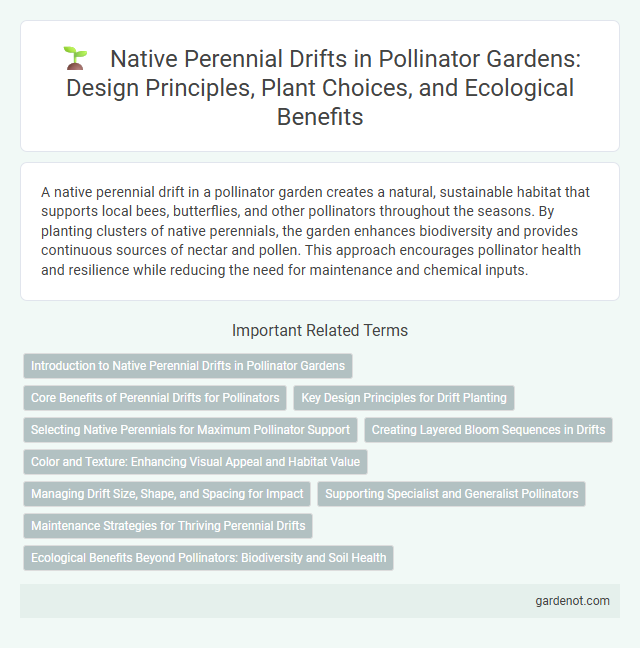A native perennial drift in a pollinator garden creates a natural, sustainable habitat that supports local bees, butterflies, and other pollinators throughout the seasons. By planting clusters of native perennials, the garden enhances biodiversity and provides continuous sources of nectar and pollen. This approach encourages pollinator health and resilience while reducing the need for maintenance and chemical inputs.
Introduction to Native Perennial Drifts in Pollinator Gardens
Native perennial drifts create continuous blooms that support pollinators throughout the growing season by providing essential nectar and pollen sources. Selecting a mix of regionally adapted species such as Echinacea, Monarda, and Rudbeckia ensures resilience and sustainability in pollinator gardens. These drifts enhance habitat connectivity, promoting the movement and diversity of native bees, butterflies, and other beneficial insects.
Core Benefits of Perennial Drifts for Pollinators
Native perennial drifts create continuous floral resources that support pollinator foraging throughout multiple seasons, enhancing nectar and pollen availability. These dense plant groupings provide essential habitat and shelter, boosting pollinator diversity and population stability. By promoting soil health and reducing maintenance, perennial drifts contribute to sustainable, thriving ecosystems critical for native pollinators like bees, butterflies, and hummingbirds.
Key Design Principles for Drift Planting
Native perennial drift planting enhances pollinator gardens by creating large, continuous clusters of a single species, which improves visibility and accessibility for pollinators like bees and butterflies. Key design principles include selecting regionally appropriate native species for resilience, grouping plants by bloom time to ensure seasonal nectar availability, and arranging drifts to mimic natural growth patterns for ecological harmony. Incorporating soil conditions and sunlight requirements in drift placement further maximizes plant health and pollinator attraction.
Selecting Native Perennials for Maximum Pollinator Support
Selecting native perennials such as purple coneflower (Echinacea purpurea), black-eyed Susan (Rudbeckia hirta), and bee balm (Monarda fistulosa) ensures robust pollinator support through extended bloom periods and diverse floral resources. These species thrive in local climates and provide essential nectar and pollen for bees, butterflies, and hummingbirds. Designing a native perennial drift maximizes habitat connectivity and enhances pollinator foraging efficiency while promoting ecological resilience.
Creating Layered Bloom Sequences in Drifts
Native perennial drifts enhance pollinator gardens by creating continuous, layered bloom sequences that support diverse pollinator species throughout the growing season. Planting staggered varieties such as Echinacea purpurea, Rudbeckia hirta, and Monarda fistulosa in clustered arrangements maximizes floral resource availability. This strategic layering promotes ecosystem resilience and sustains native bees, butterflies, and hummingbirds with sequential nectar and pollen sources.
Color and Texture: Enhancing Visual Appeal and Habitat Value
Native perennial drifts create vibrant color mosaics and varied textures that boost both visual appeal and habitat value in pollinator gardens. These plants provide continuous seasonal blooms that attract and support diverse pollinators such as bees, butterflies, and hummingbirds. Combining native species like purple coneflower, black-eyed Susan, and butterfly weed ensures ecological balance while offering rich, dynamic landscapes for wildlife.
Managing Drift Size, Shape, and Spacing for Impact
Managing drift size, shape, and spacing in a pollinator garden enhances habitat continuity and supports diverse pollinator species by optimizing floral resource availability. Large, irregularly shaped native perennial drifts create visual interest while facilitating pollinator movement and foraging efficiency. Strategic spacing between drifts ensures connectivity and biodiversity, promoting healthy pollinator populations and ecosystem resilience.
Supporting Specialist and Generalist Pollinators
Native perennial drift enhances habitat continuity, supporting specialist pollinators such as certain bee and butterfly species reliant on specific host plants. This planting strategy also benefits generalist pollinators by providing diverse forage resources across seasons, increasing overall pollinator abundance and diversity. Incorporating a variety of native perennials ensures ecological stability and resilience in pollinator gardens.
Maintenance Strategies for Thriving Perennial Drifts
Native perennial drifts thrive with minimal maintenance through targeted strategies such as selective pruning, strategic mulching, and seasonal soil enrichment to promote vigorous growth. Employing adaptive watering schedules that align with rainfall patterns conserves moisture while preventing overwatering, which is vital for root health. Regular monitoring for pest activity and disease ensures prompt intervention, maintaining the ecological balance vital for pollinator habitat sustainability.
Ecological Benefits Beyond Pollinators: Biodiversity and Soil Health
Native perennial drifts enhance biodiversity by supporting diverse insect populations, birds, and small mammals, creating a balanced ecosystem within pollinator gardens. Their deep root systems improve soil health through increased aeration, organic matter, and nutrient cycling, leading to enhanced soil structure and fertility. This ecological synergy promotes resilience against pests, diseases, and environmental stresses, ensuring long-term sustainability beyond pollinator support.
Native perennial drift Infographic

 gardenot.com
gardenot.com